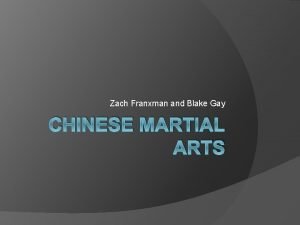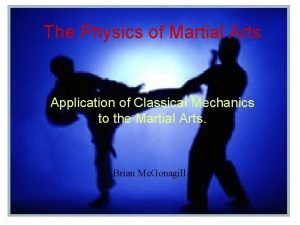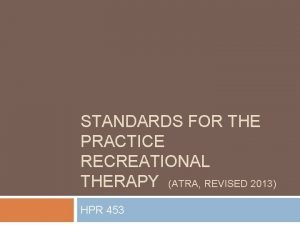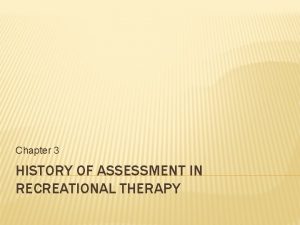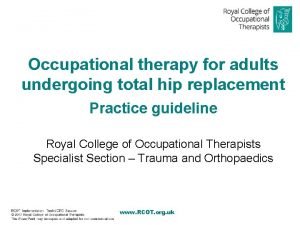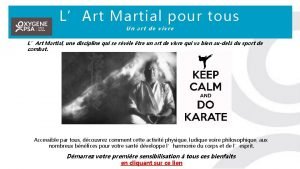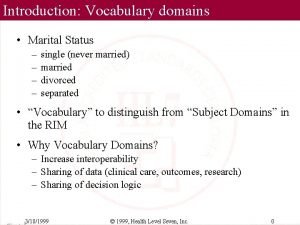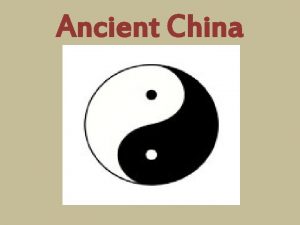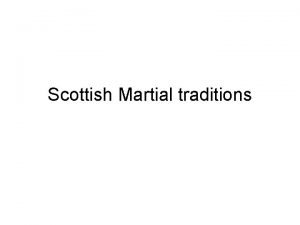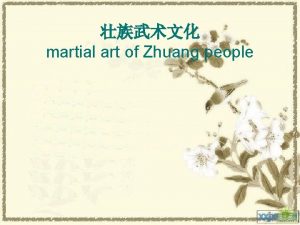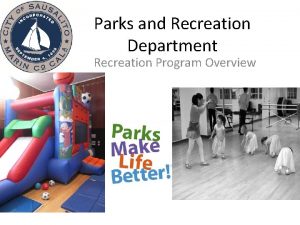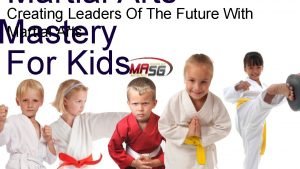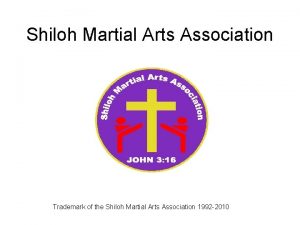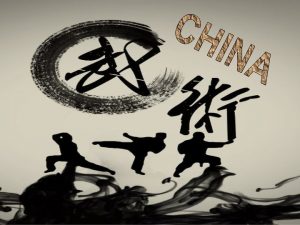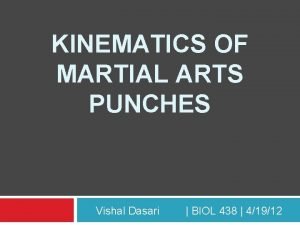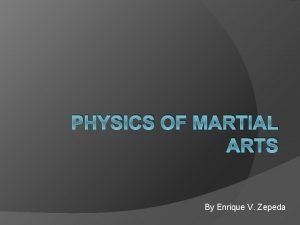Martial Arts as a Recreation Therapy Intervention ATRA



















- Slides: 19

Martial Arts as a Recreation Therapy Intervention ATRA Annual Conference 2004 – Kansas City Don Rogers, Ph. D. , CTRS Indiana State University Department of Recreation & Sport Management John Shireman, M. S. Indiana State University Department of Physical Education

Overview of Seminar: Part 1 • Introduction to Martial Arts • Variety of styles • Emphasis/strengths of each style • Inclusion potential • Focus on two styles with adaptations: • Hap Ki Do • Kali

Overview of Seminar: Part 1 • Benefits of MA • Physical benefits • Psychological benefits • Social benefits • Suggestions for applications in treatment • Physical rehabilitation • Mental health

Overview of Seminar: Part 2 • Teach beginning level techniques of Hap Ki Do • Teach beginning level techniques of Kali • Participant demonstrations of techniques learned

Introduction to Martial Arts • • • Definition Holistic nature Adaptability Instructors Students

MA Styles, Strengths & Inclusion Potential Judo • Described • Translated means “the gentle way”. • Sport oriented Martial art, in which two practitioners attempt to throw the other to the ground. • This system also uses submission holds once the players hit the ground • Strengths of the style • Great for exercise, and is also nice because of the added sport aspect. • Since there is no striking, students may perform the movements at full speed when they have spent the appropriate amount of time learning the movements. • Due to the twisting nature of the throws Judo may enhance the mobility and range of motion of the lower spine. • Inclusion potential • Judo is studied widely by people with sensory impairments.

MA Styles, Strengths & Inclusion Potential Karate • Described • Translated means “empty hand”. Originated in Okinawa. • This system of martial arts uses the hands, feet, elbow, and knees as striking tools to defeat an opponent. • Strengths of the style • This style uses katas as a means of practicing movements. • This style of martial arts is great for increasing muscular strength and endurance, as well as precision of movement. • This form of martial arts is used primarily for self-defense. • Inclusion potential • Reported among people with spinal cord injuries.

MA Styles, Strengths & Inclusion Potential Kung Fu • Described • Originated from Shaolin temples in China. • Two major divisions: Hard Schools (ex Wing Chun) and Soft Schools (ex Tai Chi) • Strengths of the style • Aside from being a great form of exercise, Kung Fu also challenges a practitioner’s ability to concentrate. • The hard systems of Kung Fu are great for self- defense. • Inclusion potential • Demonstrated effective among people with spinal cord impairments.

MA Styles, Strengths & Inclusion Potential Tai Chi • Described • This form of Kung Fu is often referred to as a “moving mediation”. • This art utilizes soft flowing movements found in Kung Fu. • Strengths of the style • The practice of Tai Chi can be performed solo, and since the student is not being thrown, punched or kicked it is easy on the body. • The practice of this art is known to relieve stress, anxiety, and tension. • Inclusion potential • Reported among people who have multiple sclerosis and arthritis.

Hap Ki Do • Way of Coordinated Power • Self-Defense – punches, kicks, falling, weapons, situations • Concept of Free Part • Five Directions of Response combined with large movements • Joint Locks • Kicks • Body Movement Drills • Adaptations: • • Use of partner’s body Effect of strikes on body position Use of assistive devices Use of distance

Kali • Philippine Stick Fighting Art • Type of sticks & parts of sticks • Striking angles • Footwork – male and female triangles • Pressure zones • Blocks • Disarms • Weaponless applications • Drills – variety • Adaptations: • • Use of grip cuff Foam covered stick Two-handed techniques Upper-body movements to avoid pressure, block, strike

Benefits of Martial Arts • Physical • Increased muscle strength & endurance • Increased cardiovascular fitness • Increased flexibility and ROM • Improved balance – upper and lower body • Improved coordination • Improved kinesthetic awareness • Decreased chronic pain

Benefits of Martial Arts • Psychological/Cognitive • • • Increased confidence Improved self-concept (pride) Increased motivation Enhanced sense of security Increased independence (autonomy) • Reduction of stress • Improved memory • Improved problem solving

Benefits of Martial Arts • Relationships & Social Skills • Opportunity to meet new people • Facilitates the development of friendships • Decreases social isolation • Improves self-awareness • Enhances respect for others • Improves ethical decision making and appropriate behaviors

Suggestions for Application in Recreation Therapy Services • Match assessed needs with appropriate MA activity • Be knowledgeable of mechanics and able to demonstrate • Be fully aware of safety concerns and how to protect clients • Diagnostic contraindications • Equipment used • Implement complimentary fitness program – strength, endurance, flexibility

Suggestions for Application in Recreation Therapy Services • Be prepared to adapt the technique when necessary • Use effective sequential learning approach – discrete skills, specific feedback & reflection • Use video tape to provide additional feedback • Provide as part of sport program • Identify community program – help develop if necessary

Martial Arts as a Recreation Therapy Intervention Seminar: Part 2 Basic Techniques of Hap Ki Do & Kali Welcome Back!

Basics of Hap Ki Do • Beginning level techniques of Hap Ki Do • Safety concerns • Protect joints – tapping • Control of punches, kicks & locks • Use of mats • Wrist escapes (milgi & slaps) • Basic joint locks (1/4 turn, ¾ turn & arm bars) • Punch defenses (inside touch, outside middle, hay-maker) • Situational defense (2 handed choke)

Basics of Kali • Beginning level techniques of Kali • Safety concerns • Control of stick • Body protection if needed • Slow movements • Five angles striking • Five angles blocking • Disarm (inside deflection into snake disarm, outside deflection into quick strip) • Coordination drill (HLH slap, symmetrical drill) • Weaponless coordination drill
 Gay martial arts
Gay martial arts Malay silat
Malay silat Martial arts physics
Martial arts physics Atra flex coupling distributors
Atra flex coupling distributors Atra flex coupling insert
Atra flex coupling insert Atra standards of practice
Atra standards of practice Recreation therapy assessment tools
Recreation therapy assessment tools Creative arts grade 7 visual arts term 3
Creative arts grade 7 visual arts term 3 Occupational therapy intervention plan for hip arthroplasty
Occupational therapy intervention plan for hip arthroplasty Performing arts physical therapy
Performing arts physical therapy Martial plé
Martial plé Classification anémie
Classification anémie What civil status
What civil status Martial pabandji
Martial pabandji Guided reading early china lesson 3 answers
Guided reading early china lesson 3 answers Psychoanalytic therapy is to as humanistic therapy is to
Psychoanalytic therapy is to as humanistic therapy is to Bioness integrated therapy system price
Bioness integrated therapy system price What are the major humanistic therapies
What are the major humanistic therapies Unit 5 recreation
Unit 5 recreation The diamond shape is used exclusively for _____ signs
The diamond shape is used exclusively for _____ signs
